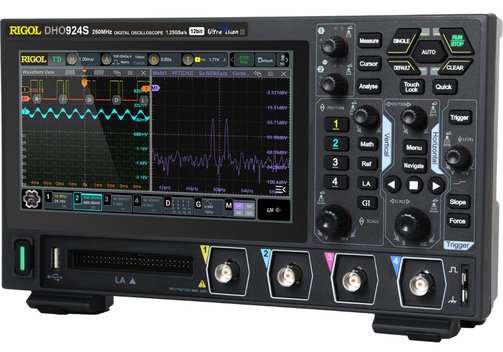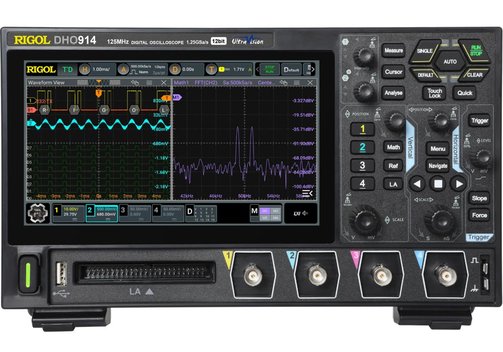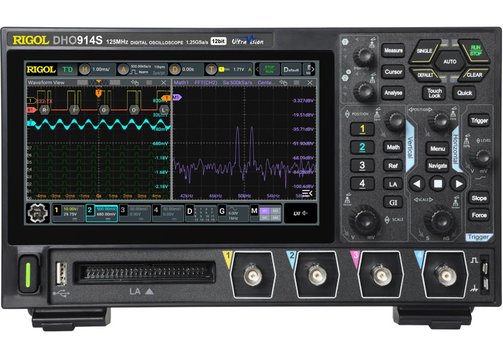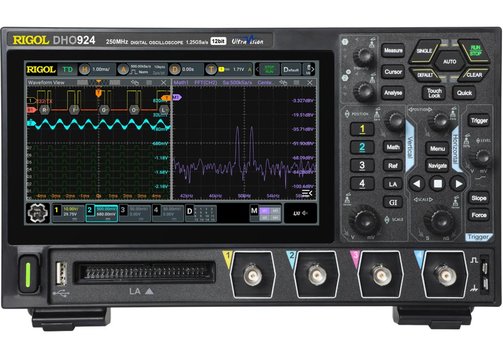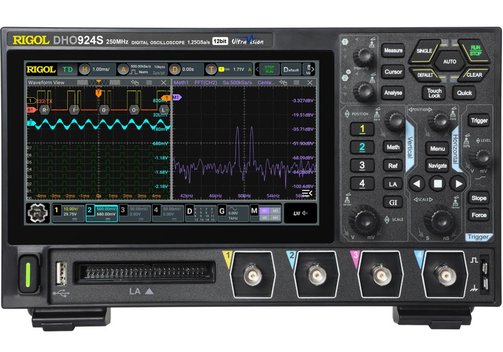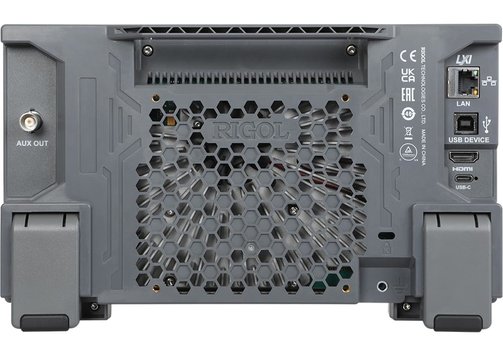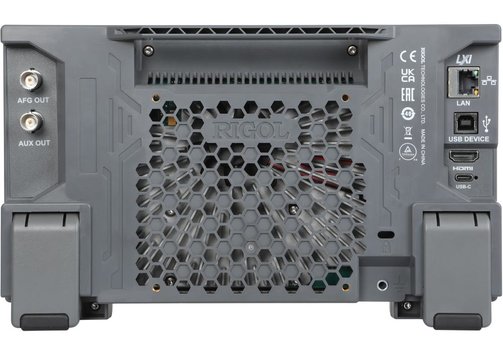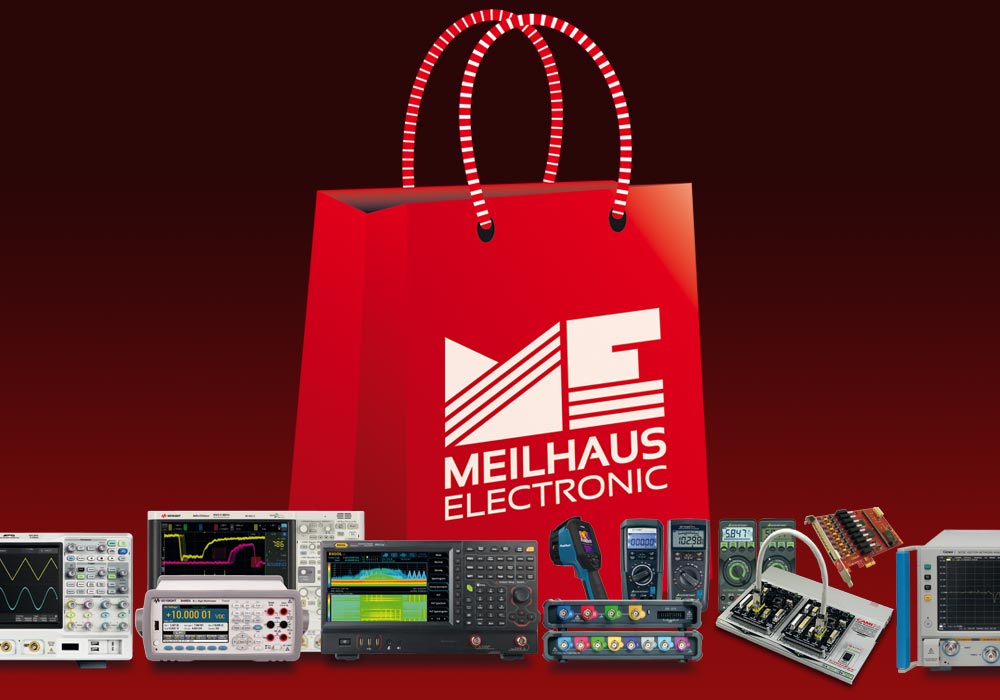Rigol DHO900 12bit Digital Oscilloscopes/MSO up to 250MHz
Benefits of the DHO900 High-Precision Multifunctional DSO/MSO with Ultra-Low Noise Floor
- Digital oscilloscopes with 4 channels, 12 bit resolution, up to 250 MHz bandwidth.
- Up to 1.25 GS/s sample rate, 1,000,000 wfms/s with UltraAcquire mode.
- Multifunctional: Logic analyzer, AFG, Bode plot, serial bus decoding and more.
Rigol DHO900 12 bit Digital Oscilloscopes/MSO up to 250 MHz
Models DHO914, DHO914S, DHO924, DHO924S with 4 + 16 Channels
The Rigol DHO900 series instruments are powerful oscilloscopes with a compact design and superior performance. They offer an acquisition rate up to 1,000,000 Wfms/s (in UltraAcquire mode), 50 Mpts memory depth, 12 bit resolution and a very low noise floor. The devices are mutlifunctional: they offer 16 digital logic channels (MSO), allowing them to analyze both analog and digital signals to meet the requirements of embedded designs and test scenarios. They also support automatic serial and parallel bus analysis, AFG (arbitrary function generator), bode plot analysis, and other functions for test, R&D, education, and scientific research.
- Ultra-low noise floor, purer signal, never miss the small signals.
- Up to 12 bit resolution.
- Max. analog bandwidth 250 MHz, 4 analog channels.
- 16 digital channels (MSO, standard), logic probe required to be purchased if needed.
- Max. real-time sample rate of 1.25 GS/s.
- Max. memory depth 50 Mpts.
- Vertical sensitivity range: 200 µV/div...10 V/div.
- Max. capture rate of 1,000,000 wfms/s (in UltraAcquire mode).
- Digital phosphor display with real-time 256-level intensity grading.
- Multifunctional with AFG (arbitrary function generator), Bode plot analysis, histogram, digital signal analysis.
- Waveform search and navigation function allows you to debug the signal anomalies faster.
- 7"/17.8 cm (1024x600) capacitive multi-touch screen and HDMI video output.
- Flex Knob brings user-friendly experience.
- USB Host and Device, LAN/Ethernet/LXI.
- Unique online upgrade.
Model Overview
| Model | DHO914 | DHO914S | DHO924 | DHO924S | |
| Channels | 4 analog input channels, 16 digital/logic input channels (required to purchase the PLA2216 logic analyzer probe) | ||||
| Bandwidth | (-3 dB) | 125 MHz | 250 MHz | ||
| Rise time | (10% to 90%, typical) | ≤2.8 ns | ≤1.4 ns | ||
| Sample rate | Single-channel | 1.25 GS/s | |||
| Dual-channel | 625 MS/s | ||||
| Full-channel | 312.5 MS/s | ||||
| Memory depth | Single-channel | 50 Mpts | |||
| Dual-channel | 25 Mpts | ||||
| Full-channel | 10 Mpts | ||||
| Max. waveform capture rate | 30,000 wfms/s (vector mode), 1,000,000 wfms/s (UltraAcquire mode) | ||||
| Resolution | 12 bit | ||||
| Hardware real-time waveform recording and playing | Max. 500,000 frames | ||||
| Trigger | Source | Analog channel (1 to 4), digital channel (D0 to D15) | |||
| Modes | Auto, normal, single | ||||
| Types | Edge, pulse, slope, video, pattern, duration, timeout, Runt, window, delay, setup/hold trigger, n-th edge, RS232/UART, I2C, SPI, CAN, and LIN | ||||
| Serial decoding | 4 protocol types can be decoded and enabled at the same time; standard: Parallel, RS232/UART, I2C, SPI, LIN, and CAN | ||||
| Peak detection | Capture 1.6 ns glitches | ||||
| Further functions | Frequency counter | Any analog channel, measure frequency, period, 48-bit totalizer (counts number of rising edges); resolution 3 - 6 digits, max. frequency is max. analog bandwidth | Digital voltmeter | Any analog channel, functions DC, AC+DCRMS, ACRMS, resolution ACV/DCV 3 digits | Arbitrary function generator (AFG) and Bode plot feature | "S"-models only: 1 channel, sample rate 156 MS/s, vertical resolution 14 bit, max. frequency 25 MHz, waveforms: Sine, square, ramp, DC, noise, user-defined/arbitrary waveform supported (frequency range 2 mHz...10 MHz, waveform length 2...16 kpts, supports loading the stored waveforms); modulations: AM, FM, PM; Bode plot: Start frequency 10 Hz...24.99 MHz, stop frequency 100 Hz...25 MHz, number of points per octave: 10 to 300, output amplitude 20 mV...5 V |
| Display | 7"/17.8 cm capacitive multitouch LCD; 1024x600 resolution; HDMI 1.4 A plug video output | ||||
| Interfaces | USB 2.0 Host and Device, LAN/Ethernet/LXI-C | ||||
| Dimensions (mm) | 265 x 162 x 77; 1.78 kg | ||||
If any one of the channels is enabled, it is called single channel mode. If two of the channels are enabled, it is called half channels mode. If any three channels or all four channels are enabled, it is called all channels mode.
Included: Oscilloscope Rigol DHO 914, 914S, 924, or 924S, power adaptor, banana plug ground connecting cable, DHO924/DHO924S: 4x passive probe (350 MHz/PVP2350), DHO914/DHO914S: 4x passive probe (150 MHz/PVP3150);
optional, not included: 16-channel logic analyzer probe PLA2216.

Frequently Asked Questions:
Question: 8 bit, 12 bit - which vertical resolution do I need for my oscilloscope? Or: Why an "HD scope"?
Answer: The vertical resolution of the oscilloscope is the resolution of the A/D converter in the oscilloscope. During the A/D conversion of a signal, an analog, value- and time-continuous signal becomes a value- and time-discrete signal. The infinite number of voltage values thus becomes a limited number of values that can be binary coded during digitization. The determining variable here is the bit width of the A/D converter. With a 16-bit converter, for example, 65,536 values can be represented (4096 with 12 bit, 256 with 8 bit). Strictly speaking, the digitized signal is always only an approximation of the original signal. The higher the resolution and rate, the better this approximation, but the higher the amount of data produced. However, the A/D converter is still a price-sensitive component.
For classic DSOs (digital storage oscilloscopes), a resolution of 8 bit is still the standard at the present time. For many applications this is perfectly sufficient. But the modern converter technology allows of course also higher resolutions like eg. with the Rigol DHO series. And this gradually also at more and more favorable prices (we are talking here about "real" 12-bit conversion, not about "extended" modes with reduced bandwidth generated by mathematical filter algorithms etc.). There are applications where these higher resolutions are required - for example, when capturing and analyzing high dynamic range signals, when capturing small signals in the context of large signal amplitudes. Small details become more visible and sharper signals are possible.
Related Products
Customers also bought






















